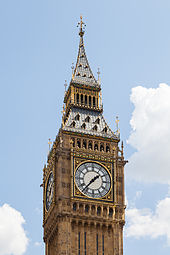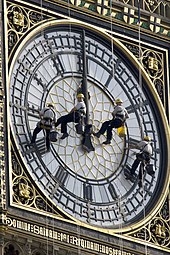Big Ben
The name Big Ben ( Engl. Short for "big Benjamin") refers to the 13.5 t weight heaviest of the five bells of the famous clock tower at the Palace of Westminster in London .
The name Big Ben is also often transferred to the clock or clock tower . Since September 2012 the tower has been officially called Elizabeth Tower . The renaming of the former clock tower took place on the occasion of the diamond jubilee of Queen Elizabeth II and was approved by the British Parliament .
Bells
The Great Bell is already the second bell in the tower , as the first broke during the dress rehearsal in 1857. At the first attempt, the bell cast by “John Warner & Sons” in London in 1856 weighed just under 17 instead of the intended 14 tons . Because of this miscalculation and a hammer that was much too heavy, she suffered a crack over two meters long during the first test. It was decided to melt the bell again and cast a new one with the material. This was cast on April 10, 1858 by the "Whitechapel Bell Foundry" and installed in the tower in October of the same year. After the clockwork was started on May 31, 1859, the bell from the clock tower rang for the first time on July 11, 1859. But the new bell also got a crack in September 1859 and was then turned so that the hammer no longer hit the Riss could hit. The weight of the hammer has also been drastically reduced.
The origin of the name Big Ben is not clearly established. There are two main theories:
- According to Sir Benjamin Hall , the First Commissioner of Works at the time the bell was installed
- After Ben Caunt , a heavyweight boxer who had his last fight in 1857.
Next to it are four quarter-hour bells that play the famous Westminster chime every quarter of an hour. The bells play with the tones # G # 1 , F # 1 , e 1 , h 0 every fifteen minutes. The melody consists of 20 notes in 5 bars, in which the four notes are played in a different order. The number of bars played corresponds to the number of quarter hours that have passed.
Elizabeth Tower
Today the whole tower is commonly referred to as Big Ben , although this name is incorrect. Until September 2012, the tower was officially referred to as The Clock Tower . The name St. Stephen's Tower is also often used incorrectly . In September 2012 the tower was renamed Elizabeth Tower in honor of Queen Elizabeth II's 60th jubilee .
The tower is 96.3 meters high, with the first 61 meters made of brick with a limestone facade and the top made of cast iron. Charles Barry , the architect of the Palace of Westminster, commissioned Augustus Pugin to design the tower, the construction of which was completed in 1858. The tower housed a prison for members of the two houses of parliament. The prison was last used in 1880 when Charles Bradlaugh refused to take the religious oath .
Today the tower is inclined by 0.26 ° and thus has an overhang of 46 cm.
The Elizabeth Tower can be visited as part of a guided tour, but since 2010 only by residents of Great Britain. Before that, for security reasons with regard to possible terrorist attacks on the landmark, access checks for guests from other countries were carried out. However, since these were very complex, the procedure was changed.
The clock tower is one of the most famous landmarks in London .
- Elizabeth Tower
Tower clock
The movement was designed by Sir George Airy and Edmund Denison in 1848 and manufactured by watchmaker Edward John Dent . The diameter of the four dials is seven meters each. The minute hands are 4.3 meters long and the hour hands are 2.74 meters. This makes it the second largest watch in Great Britain . Under each of the four dials there is the Latin inscription “Domine salvam fac reginam nostram Victoriam primam” (“God save our Queen Victoria the First ”).
To ensure that the clock works properly, four mechanics are on duty around the clock, the Keeper of the Great Clock . An electric motor is switched on three times a week to wind the clock. The clock has a pendulum 3.9 meters long with a total weight of 299 kg and an oscillation period of two seconds. Fine tuning is traditionally done with penny coins , which are placed on a tray attached to the end of the pendulum in order to change the center of gravity and thus the period of oscillation.
During the Second World War , the BBC stopped the hourly live broadcast of the bell tone on the radio, which had been customary since 1923, and instead broadcast a recording. They wanted to prevent the war opponent from receiving meteorological information from the sound and echo of Big Ben.

In August 1945 there was a disruption when a large number of starlings kept sitting on the hands of the clock and slowing its progress. For the same reason, the clock ran out for almost five minutes in 1949. On New Year's Eve 1962, icy temperatures blocked the mechanics, so that the New Year could only be heralded ten minutes late. On May 1, 2004, the quarter-hourly chimes stopped. Although the bell tower still indicated the time on the hour with its characteristic low tone, the chimes, which usually sounded every quarter of an hour, were canceled for about a week. The reason for the failure was a torn off counterweight weighing tons.
On May 27, 2005, the movement stopped for around 90 minutes for reasons that were initially unknown . In the 146 years since it was built, this had only happened four times. Much of the British media blamed the exceptionally high temperatures of 31 ° C. According to the BBC, however, a defective gear should have been the cause. As part of the time change in 2005, the clock was stopped on Saturday, October 29, 2005 at 8:00 a.m. local time to perform maintenance. The movement was restarted on Sunday at 4 p.m. Greenwich Mean Time (5 p.m. CET).
From August 11, 2007, the carillon was silent for seven weeks as the tower was renovated for the 150th anniversary. The clock kept on, but the familiar melody did not play. The BBC, which traditionally begins the 6pm news with the live sound of Big Ben, broadcast the Greenwich time signal instead. On October 1st from 12 noon everything was back to normal. The live sound can be heard worldwide on BBC World Service .
Since August 21, 2017, after the bells had rung at 12 noon, the carillon has again been suspended for renovation work. However, on special occasions, such as the New Year, the bell should sound anyway. The entire tower will be scaffolded for the work, which is expected to last until 2021 and is currently estimated at around 61 million pounds (equivalent to around 68 million euros). In addition to the clockwork, both the limestone facade and the corrosion on the cast iron roof are to be repaired. In addition, adjustments to safety and fire protection are planned and the glass of the dials will be replaced. The new almost 1,300 glass elements were manufactured over several months in the Lamberts glassworks from Waldsassen in the Nuremberg metropolitan region in the traditional way in several work steps and are each hand-blown unique pieces. Furthermore, an elevator, which should facilitate future work, is to be installed and the dials with LED lights that can change their color can be backlit.
See also
Web links
Individual evidence
- ↑ "Big Ben" bell tower is now called "Elizabeth Tower" Hamburger Abendblatt dated September 12, 2012
- ^ Website of the British Parliament
- ↑ a b "Big Ben, one hundred years old", Eric Mettler in: Neue Zürcher Zeitung of May 23, 1959
- ↑ Joanna Sugden: Big Ben rings in its 150th year . In: The Times . July 10, 2009. Retrieved July 12, 2009.
- ↑ a b c d Ruth Rach: When the queen of all clocks rang for the first time. In: Calendar sheet (broadcast on DLF ). July 11, 2019, accessed July 11, 2019 .
- ↑ Bong! Big Ben becoming leaning tower of London, say engineers , The Telegraph
- ^ Leaning tower of Big Ben worries MPs , The Guardian
- ↑ Big Ben and the Elizabeth Tower tours , British Parliament website
- ^ Only British citizens are allowed on tours of Big Ben as security fears force ban on foreigners , Daily Mail Online
- ↑ Construction work on Big Ben at Urlaubsguru.at, accessed on August 2, 2019
- ↑ Oberpfälzer Glas shines over London by André Ammer, in: Nürnberger Nachrichten of August 2, 2019.
- ↑ Construction work on Big Ben at Urlaubsguru.at, accessed on August 2, 2019
Coordinates: 51 ° 30 ′ 3 " N , 0 ° 7 ′ 28" W.







